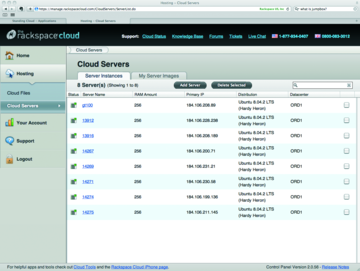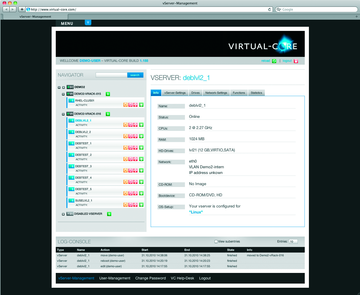« Previous 1 2 3 Next »
Overview of cloud platforms and appliances
Obscured by Clouds
Highs and Lows
In contrast to the Amazon cloud, Rackspace has a clear-cut GUI that is free of legacy restrictions (Figure 3) [5]. Because of the user friendliness of the Rackspace Cloud and the static IP addresses that any Rackspace Cloud Server is assigned until you delete the server, the Rackspace Cloud scored 112 in our index.
 Figure 3: The Rackspace Cloud. Despite the minimalist GUI, you can achieve much with just a couple of clicks.
Figure 3: The Rackspace Cloud. Despite the minimalist GUI, you can achieve much with just a couple of clicks.
Provider Kamp doesn't advertise its Virtual Core product as a cloud and doesn't claim to offer cloud services [6]. Surprisingly, the Virtual Core Web GUI (Figure 4) is based on the Typo 3 Content Management System and not on a web application framework such as Ruby on Rails.
 Figure 4: Kamp Virtual Core (developer version). Kamp plans to release its English product in the first quarter of 2011.
Figure 4: Kamp Virtual Core (developer version). Kamp plans to release its English product in the first quarter of 2011.
Virtual Core doesn't currently implement some of the features offered by cloud services, but it is more innovative in some other areas. For example, you can easily set up a software appliance with IPv6 addressing on the Virtual Core platform within about four minutes.
Currently, Virtual Core lacks sophisticated self-service features; however, administrators can contact support if they have special requirements, such as additional VLANs for cluster heartbeats or special Service Level Agreements (SLAs).
In comparison, Amazon EC2 offers a standard SLA that guarantees 99.95 percent availability without any restrictions. Rackspace offers 100 percent but does not count planned maintenance with a notification period of 24 hours. Basically, Rackspace's Cloud SLAs only apply to power or heat issues. The Strato MultiServer didn't fare quite so well in our index. Although the product is advertised as "Dedicated Cloud Hosting," it is not a genuine cloud according to the Admin magazine definition [7]. Instead, it refers to a dedicated server on which the Xen hypervisor is preinstalled. The product itself is eminently usable but has very little to do with a real cloud, which explains why it only scores 23 in the AMCI.
MS Azure
Microsoft's view of the cloud world, the Microsoft Azure Online [8] Cloud Platform, didn't fare well in our index because its focus is on (Microsoft) applications and services, not on providing virtual servers. Microsoft refers to Azure as the first cloud operating system – others consider it PaaS (e.g., similar to the Google App Engine).
MS Azure is a cloud operating system on which users can run Microsoft, PHP, and Ruby on Rails applications. Rather than managing the virtual server, you manage the service that you provide (or the application). Microsoft relies totally on products from its own universe – MS SQL Server, Dotnet frameworks, Live/Presence technologies, and so on – which are tightly integrated to the exclusion of all others. You can't use Azure to run an Exchange or OCS server in the cloud. Microsoft offers a different product for this (Business Productivity Online), which is more in the vein of Application Hosting (i.e., SaaS).
Even Microsoft critics have to admit that the vision behind Azure is seminal and future-proof. Administrators don't want to run clouds just for the sake of doing so; instead, they want to launch applications in them. They view maintenance (installing patches, etc.) on a virtual operating system platform as an unnecessary overhead.
On top of this, every application on an Azure Cloud operating system has its own IP address, a concept that has potential for terminal devices (hosts, laptops) on IPv6. On the other hand, a service- or application-oriented technology like this is very close to shared hosting.
The developers of the Amazon Cloud recently founded Nimbula (whose largest investor is VMware) and announced their own Cloud OS [9]. What the Nimbula Cloud OS will offer and how, and whether it will be similar to the MS Azure Cloud OS, is still uncertain. Because both products aim to be cloud operating systems, it is quite possible that they are based on similar visions.
Operation Questions
VMware has an advantage in the virtualization market because of its history [10]. Currently VMware accounts for the largest share of the market, with around 68 percent of the end users.
Most VMware administrators would thus instinctively want to create a cloud with the vCloud Director, because it is the commercial product that comes closest to being a cloud. Having said that, commercial clouds typically aren't part of commercial products but are based on the community version of Xen or on KVM. If the inside of the cloud depends on a single vendor, likely the flexibility of self-service and pay as you go will be difficult to offer to end users. Linux certainly gives providers the flexibility and economy they need.
Additionally, clouds have a couple of technical (and some less technical) requirements of their users. Whether a cloud offers static IP addresses or not, applications that you run in the cloud should always be designed in such a way that DHCP or NAT doesn't bother them.
Even though innovative cloud providers (e.g., Rackspace or Kamp) support static IP addresses that do not require NAT, you shouldn't rely on this, especially if you might need to migrate between clouds some time in the future, which would automatically change the IP addresses.
No problems are expected with Linux, but Microsoft products are a different case. Any administrator who has tried to modify the IP address of an Active Directory Domain Controller will be aware that this is not a trivial task. Even with the less invasive changes caused by the cloud – such as one part of the infrastructure (or an application) running in your own server room and the others running in the cloud – you must take several obstacles in stride when using Microsoft technologies. Fortunately, Microsoft has seen the issues and has announced changes through blogs and developer conferences under the code name Next Generation Active Directory (NGAD). NGAD will make Microsoft Windows, including all of its components (SharePoint, Exchange, OCS, etc.), as fit for the cloud as Linux systems.
Right now, the cloud and cloud-based services (such as Software Appliances, virtualization, licensing, and so on) appear to offer a historic opportunity for Linux.
« Previous 1 2 3 Next »
Buy ADMIN Magazine
Subscribe to our ADMIN Newsletters
Subscribe to our Linux Newsletters
Find Linux and Open Source Jobs
Most Popular
Support Our Work
ADMIN content is made possible with support from readers like you. Please consider contributing when you've found an article to be beneficial.




